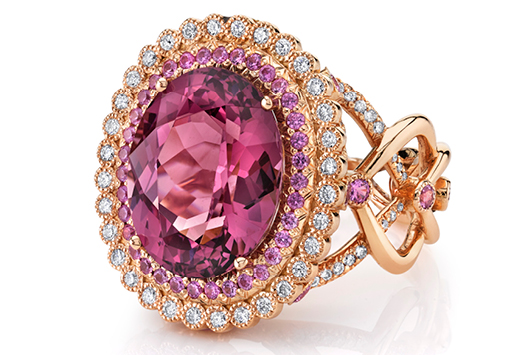
Afshin Hackman recently had the best week of sales in the history of his company, Intercolor. What sold? Blue sapphires — a lot of them — and he’s thrilled with what seems like an early Christmas bonanza.
“Blue sapphire remains the best-selling stone of all time,” says the company principal. “The color blue appeals to most people, there is a higher percentage of sapphires that are clean compared to rubies and emeralds, and they are a lot more readily available.”
As the 2019 Tucson gem shows grow closer, Rapaport Magazine has reached out to insiders in the colored-stone arena to find out some of the materials we should expect to be popular next year. Not surprisingly, this cool-colored favorite is among them, as are some brighter looks seen on high-profile wearers, and neutral shades that work well with many ensembles.
Get the blues
From sapphires to zircon and aquamarine, the color blue remains a best seller. Los Angeles-based jewelry designer Pamela Froman favors blue moonstone and zircon for their soft palettes that play well with other shades. For Hackman, medium to lighter blue stones sell better in northern states, while richer-hued ones move more down south.
Then there is aquamarine, a star in Assael’s line, according to Peggy Grosz, director of business and product development for the New York-based firm. “It’s strong and soft at the same time and is strangely neutral,” she says.
And while pearls are the DNA of jeweler Imperial in Providence, Rhode Island, the brand has been dipping its toes into color, starting with blue sapphires. “We’re pairing pear-shape blue sapphires with white akoya pearls for a fresh new take on iconic gems,” says Kathy Grenier, vice president of business development.
Paraiba tourmaline — a favorite of Froman’s, as well as of fellow Angelino designer and stone dealer Erica Courtney — also gets some play, though it’s neither easy nor cheap to source today.
Claim to fame
When Britain’s Princess Eugenie got engaged in January with an oval-shape, peach-colored padparadscha sapphire, gem dealers experienced a bump in sales of similarly colored stones.
“Between January and May, I must have sold upward of 75 1- to 4-carat, pink and peach sapphires,” relates Hackman, who recalls a similar boost when singer-actress Jennifer Lopez got engaged with a pink diamond at the turn of the ’00s.
Laurie Watt, a principal at gem dealer Mayer & Watt in Maysville, Kentucky, also saw a rise in peach sapphire sales because of the royal engagement.
Froman, however, points out a caveat: While padparadscha sapphires may be trending because of news reports, that doesn’t mean supply can meet demand. “You won’t see pads popping up in jewelry everywhere, because there’s simply not enough of it,” she says. This fact gives other stones in like colors a chance to sell, despite some store owners’ resistance to pinks. At a New Jersey jewelry store over the summer, Froman surprised the proprietor by selling four pieces with pink stones.
Neutral territory
Neutral colors of gems, particularly gray ones, are also in demand — especially among millennials. Watt maintains that gray spinel, Montana sapphires, and asteriated diamond slices sell well for their softer hues, which pair nicely with many other colors. At press time, she was even packing up two big trays of this material to take on the road for sales in California.
Susan Wheeler of the eponymous Chicago-based jewelry firm — who also founded the Chicago Responsible Jewelry Conference — agrees that neutrals are the top choice among millennials. Her own neutral inventory includes gray moonstones, Tahitian black pearls (a sustainable choice, because they only grow in pristine aquatic environments), green beryl, and even a light pink morganite from Nigeria. She also goes for Ethiopian opal that’s been tumbled to offer a more beige or tan hue. “Softer colors are what people will buy,” she explains.
Froman had a millennial recently purchase an opal piece from her that was more neutral and not at all flashy. “It had more boulder in it,” she says. Other muted shades her young buyers like include rainbow and blue moonstone and platinum rutilated quartz, which isn’t easy for her to find but has become a signature look in her line.
Last year, when Wheeler was asked to create a neutral-color piece for a school raffle prize, she immediately — and perhaps surprisingly — thought of green beryl for its gentle pastel shade. “Since I’ve stopped working with many diamonds because of their traceability issues, I’ve missed neutral colors,” she says. “Like blue jeans, neutrals are super soft and go with everything.”
Image: Lila ring in 18-karat rose gold with a 13-carat Mahenge garnet, pink sapphires, and diamonds ericacourtney.comArticle from the Rapaport Magazine - December 2018. To subscribe click here.